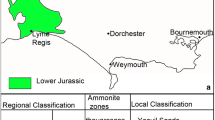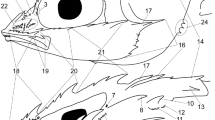Abstract
An examination of the osteology and myology of the Champsodontidae reveals a number of, apomorphic features (e.g., double-headed palatine, large pelvic radial, expaxial muscle inserting on the medial pelvic-fin ray, posterior levator internus inserting on the third epibranchial). The evidence for a Champsodontidae/Chiasmodontidae relationship is examined through a re-evaluation of the basal characters used to define the suborder Trachinoidei. The Champsodontidae are removed from the Trachinoidei and a chiasmodontid sister relationship is rejected. After investigation of several possible alternative relationships (Paracanthopterygii, Gobioidei, Callionymoidei, Kurtoidei, Apogonidae, Blennioidei, Trichodontidae), champsodontids are hypothesized to be members of the perciform suborder Scorpaenoidei. This hypothesis is based largely on the synapomorphy of a parietal spine with an opening for passage of the supratemporal sensory canal, a unique condition of champsodonitds and some scorpaenoids. A shared Type 1 expaxial muscle morphology, with separate fibre insertions on the distal tips of the spine-bearing dorsal-fin pterygiophores, is unusual and probably derived among perciforms. Champsodontids also share with some scorpaenoids Type 5 spinoid scales and the origin of Baudelot's ligament from the first vertebra rather than the basi-occipital, although neither of these features is unique to these taxa. The occurrence of an enclosed sensory canal on the parietals of Trichodontidae suggest that their relationships might also lie with the Scorpaenoidei. Arguments pertaining to the removal of champsodontids from the trachinoids apply equally to the hypothesized membership of the Cheimarrichthyidae, Pinguipedidae, Percophididae, Trichonotidae, Creediidae, Chiasmodontidae, and notothenioids in the Trachinoidei. Inclusion of these taxa within the Trachinoidei is not well-supported, and their relationships require further investigation.
Similar content being viewed by others
Literature Cited
Alcock, A. 1899. A descriptive catalogue of the Indian deep-sea fishes in the Indian Museum, being a revised account of the deep-sea fishes collected by the Royal Indian Marine Survey Ship Investigator. Calcutta. 211 pp.
Bock, W. J. and C. R. Shear. 1972. A staining method for gross, dissection of vertebrate muscles. Anat. Anz. Bd., 130 (S): 222–227.
Boulenger, G. A. 1901. Notes on the classification of teleostean fishes. I. On the Trachinidae and their allies. Ann. Mag. Nat. Hist., Ser. 7, 8: 261–271.
Dingerkus, G. and L. D. Uhler. 1977. Enzyme clearing of alcian blue stained whole small vertebrates for demonstration of cartilage. Stain Technol., 52: 229–232.
Eschmeyer, W. N. 1990. Catalog of the genera of Recent fishes. California Academy of Sciences, San Francisco, 697 pp.
Fink, W. L. 1981. Ontogeny and phylogeny of tooth attachment modes in actinopterygian fishes. J. Morphol., 167: 167–184.
Freihofer, W. C. 1963. Patterns of the ramus laterlais accessorius and their systematic significance in teleostean fishes. Stanford Ichthyol. Bull., 8: 79–189.
Fujita, K. 1989 Nomenclature of cartilaginous elements in the caudal skeleton of teleostean fishes. Japan. J. Ichthyol., 36: 22–29.
Fujita, K. 1990. The caudal skeleton of teleostean fishes. Tokai University Press, Tokyo. 897 pp., 2 pls.
Gill, A. C. 1996. Comments on an intercalar path for the glossopharyngeal (cranial IX) nerve as a synapomorphy of the Paracanthopterygii and on the position of the Gobiesocidae (Teleostei: Acanthomorpha). Copeia, 1996: 1022–1029.
Gill, A. C. and R. D. Mooi. 1993. Monophyly of the Grammatidae and of the Notograptidae, with evidence for their phylogenetic positions among perciforms. Bull. Mar. Sci., 52: 327–350.
Gill, A. C. and J. E. Randall. 1994.Chlidichthys cacatuoides, a new species of pseudoplesiopine dottyback from southern Oman, with a diagnosis of the genusChlidichthys Smith, and new record ofPseudochromis punctatus Kotthaus from Oman (Teleostei: Perciformes: Pseudochromidae). Ravue Fr. Aquariol., 21: 11–18.
Gosline, W. A. 1971. Functional morphology and classification of teleostean fishes. University Press of Hawaii, Honolulu. 208 pp.
Greenwood, P. H., D. E. Rosen, S. H. Weitzman and G. S. Meyers 1966 Phyletic studies of teleostean fishes, with a provisional classification of living forms. Bull Am. Mus. Nat. Hist., 131: 339–456.
Günther, A. 1867. Descriptions of some new or little-known species of fishes in the collection of the British Museum. Proc. Zool. Soc London, 1876 (pt 1):99–104.
Hastings, P. A. 1993. Relationships of fishes of the perciform suborder Notothenioidei. Pages 99–107in R. G. Miller, ed. A hisotry and atlas of the fishes of the Antarctic Ocean. Foresta Institute for Ocean and Mountain Studies, Carson City, Nevada.
Hoese, D. F. and A. C. Gill. 1993. Phylogenetic relationships of eleotridid fishes (Perciformes: Gobioidei). Bull. Mar. Sci., 52: 415–440.
Ishida, M. 1994. Phylogeny of the suborder Scorpaenoidei (Pisces: Scorpaeniformes). Bull. Nansei Natl. Fish. Res. Inst., 27: 1–112.
Johnson, G. D. 1984. Percoidei: development and relationships. Pages 464–498in H. G. Moser, W. J. Richards, D. M. Cohen, M. P. Fahay, A. W. Kendall, Jr. and S. L. Richardson, eds. Ontogeny and Systematics of Fishes. Am. Soc. Ichthyol. Herpetol. Spec. Publ. 1.
Johnson, G. D. 1992. Monophyly of the ueteleostean clades—Neoteleostei, Eurypterygii, and Ctenosquamata. Copeia, 1992: 8–25.
Johnson, G. D. 1993. Percomorph phylogeny: progress and problems. Bull. Mar. Sci., 52: 3–28.
Johnson, G. D. and E. B. Brothers. 1993.Schindleria: a paedomorphic goby (Teleostei: Gobioidei). Bull. Mar. Sci., 52: 441–471.
Johnson, G. D. and C. Patterson. 1993. Percomorph phylogeny: a survey of acanthomorphs and a new proposal. Bull. Mar. Sci., 52: 554–626.
Johnson, R. K. and D. M. Cohen. 1974. Results of the research cruises of FRV “Walter Herwig” to South America. XXX. Revision of the chiasmodontid fish generaDysalotus andKali, with descriptions of two new species. Arch. Fischerei Wiss., 25: 13–46.
Jordan, D. S. 1923. A classification of fishes including families and genera as far as known. Stanford Univ. Publ., Univ. Ser., Biol. Sci., 3: 77–243.
Kido, K. 1988. Phylogeny of the family Liparididae, with the taxonomy of the species found around Japan. Mem. Fac. Fish. Hokkaido Univ., 35: 125–256.
Leviton, A. E., R. H. Gibbs, Jr. E. Heal and C. E. Dawson. 1985. Standards in herpetology and ichthyology. Part I: Standard symbolic codes for institutional resource collections in herpetology and ichthyology. Copeia, 1985: 802–832.
Markle, D. F. 1989. Aspects of character homology and phylogeny of the Gadiformes. Pages 59–88in D. M. Cohen, ed. Papers on the systematics of gadiform fishes. Nat. Hist. Mus. Los Angeles Co., Sci. Series, 32: 1–262.
Matsubara, K., A. Ochiai, K. Amaoka and I. Nakamura. 1964. Revisional study of the trachinoid fishes of the family champsodontidae from the waters around Japan, and Tonking Bay Bull. Misaki Mar. Biol. Inst. Kyoto Univ., 6: 1–20.
Mooi, R. D. 1993. Phylogeny of the Plesiopidae (Pisces: Perciformes) with evidence for the inclusion of the Acanthoclinidae. Bull. Mar. Sci., 52: 284–326.
Mooi, R. D. and A. C. Gill. 1995. Association of epaxial musculature with dorsal-fin pterygiophores in acanthomorph fishes, and its phylogenetic significance. Bull. Nat. Hist. Mus. Lond. (Zool.), 61: 121–137.
Nakabo, T. 1983. Comparative osteology and phylogenetic relationships of the dragonets (Pisces: Callionymidae) with some thoughts of their evolutionary history. Publ. Seto Mar. Biol. Lab., 28: 1–73.
Nelson, D. W. 1984. Systematics and distribution of cottid fishes of the generaRastrinus andIcelus. Occ. Pap. Cal. Acad. Sci., 138: 1–58.
Nelson, J. S. 1976. Fishes of the world. John Wiley and Sons, New York. 416 pp.
Nelson, J. S. 1984. Fishes of the world, 2nd ed. John Wiley and Sons, New York. 523 pp.
Nelson, J. S. 1985. On the relationships of the genera of Creediidae (Perciformes: Trachinoidei). Japan. J. Ichthyol., 32: 283–293.
Nelson, J. S. 1994. Fishes of the world, 3rd ed. John Wiley and Sons, New York, 600 pp.
Nemeth, D. 1994. Systematics and distribution of fishes of the family Champsodontidae (Teleostei: Perciformes), with descriptions of three new species. Copeia, 1994: 347–371.
Norman, J. R. 1929. The teleostean fishes of the family Chiasmodontidae. Ann. Mag. Nat. Hist., Ser. 10, 3: 529–544.
Norman, J. R. 1957. A draft synopsis of the orders, families and genera of Recent fishes and fishlike vertebrates. Trustees Brit. Mus. (Nat. Hist.) London. 649 pp.
Patterson, C. and D. E. Rosen. 1989. The Paracanthopterygii revisited: order and disorder. Pages 5–36in D. M. Cohen, ed. Papers on the systematics of gadiform fishes. Nat. Hist. Mus. Los Angeles Co. Sci. Series, 32: 1–262.
Patterson, C. and G. D. Johnson. 1995. Intermuscular bones and ligaments of teleostean fishes. Smithson. Contrib. Zool., 559: i-iv +1–83+pullout table.
Pietsch, T. W. 1989. Phylogenetic relationships of trachinoid fishes of the family Uranoscopidae. Copeia, 1989: 253–303.
Pietsch, T. W. and C. P. Zabetian. 1990. Osteology and interrelationships of the sand lances (Teleostei: Ammodytidae). Copeia, 1990: 78–100.
Regan, C. T. 1913 The classification of the percoid fishes. Ann. Mag. Nat. Hist. Ser. 8, 12: 111–145.
Regan, C. T. 1914 XV. Pisces. Pages 1–44in D. Sharp, ed. The Zoological Record, Vol. 50, XVIII chapters. Harrison and Sons, London.
Roberts, C. D. 1993. Comparative morphology of spined scales and their phylogenetic significance in the Teleostei. Bull. Mar. Sci., 52: 60–113.
Rosen, D. E. and C. Patterson. 1990. On Müller's and Cuvier's concepts of pharyngognath and labyrinth fishes and the classification of percomorph fishes, with an atlas of percomorph dorsal gill arches. Am. Mus. Novitates, (2983): 1–57.
Sideleva, V. G. 1982. Seismosensory Systems and Ecology of the Baikalian, Sculpins (Cottoidei). Novisibirsk: Isv. Nauka, Akad. Nauk. SSSR. 149 pp. (In Russian.)
Smith, M. M. and P. C. Heemstra. 1986. Smith's sea fishes. Macmillan South Africa Ltd., Johannesburg. 1047 pp.
Springer, V. G. 1988.Rotuma lewisi, new genus and species of fish from the southwest Pacific (Gobioidei, Xenisthmidae). Proc. Biol. Soc. Wash., 101: 530–539.
Springer, V. G. 1993. Definition of the suborder Blennioidei and its included families (Pisces: Perciformes). Bull. Mar. Sci., 52: 472–495.
Stiassny, M. L. J. 1981. Phylogenetic versus convergent relationship between piscivorous cichlid fishes from Lakes Malawi and Tanganyika. Bull. Br. Mus. Nat. Hist. (Zool.), 40: 67–101.
Taylor, W. R. 1967. An enzyme method for clearing and staining small vertebrates. Proc. U. S. Natl. Mus., 122: 1–17.
Taylor, W. R. and G. G. Van Dyke. 1985. Revised procedures for staining and clearing small fishes and other vertebrates for bone and cartilage study. Cybium, 9: 107–119.
Watson, W. 1989. Champsodontidae—gapers. Pages 254–258in J. M. Leis and T. Trnski, eds. The larvae of Indo-Pacific shorefishes. New South Wales University Press, Kensington.
Watson, W., A. C. Materese and E. G. Stevens. 1984. Trachinoidea: development and relationships. Pages 554–561in H. G. Moser, W. J. Richards, D. M. Cohen, M. P. Fahay, A. W. Kendall, Jr. and S. L. Richardson, eds. Ontogeny and systematics of fishes. Am. Soc. Ichthyol. Herpetol. Spec. Publ. 1.
Weber, M. 1913. Die fische der Siboga-expedition. Leiden, E. J. Brill. 710 pp.
Winterbottom, R. 1974. A descriptive synonymy of the striated muscles of the Teleostei. Proc. Acad. Nat. Sci. Phila., 125: 225–317.
Winterbottom, R. 1993. Search for the gobioid sister group (Actinopterygii: Percomorpha). Bull. Mar. Sci., 52: 395–414.
Yabe, M. 1985. Comparative osteology and myology of the superfamily Cottoidesa (Pisces: Scorpaeniformes), and its phylogenetic classification. Mem. Fac. Fish., Hokkaido Univ., 32: 1–130.
Author information
Authors and Affiliations
About this article
Cite this article
Mooi, R.D., David Johnson, G. Dismantling the trachinoidei: evidence of a scorpaenoid relationship for the Champsodontidae. Ichthyological Research 44, 143–176 (1997). https://doi.org/10.1007/BF02678694
Received:
Revised:
Accepted:
Published:
Issue Date:
DOI: https://doi.org/10.1007/BF02678694




